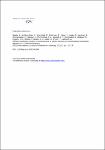Surface-associated motility, a common trait of clinical isolates of Acinetobacter baumannii, depends on 1,3-diaminopropane
Skiebe, Evelyn
Berardinis, Véronique de
Morczinek, Peter
Kerrinnes, Tobias
Faber, Franziska
Lepka, Daniela
Hammer, Bettina
Zimmermann, Ortrud
Ziesing, Stefan
Wichelhaus, Thomas A.
Hunfeld, Klaus-Peter
Borgmann, Stefan
Gröbner, Sabine
Higgins, Paul G.
Seifert, Harald
Busse, Hans-Jürgen
Witte, Wolfgang
Pfeifer, Yvonne
Wilharm, Gottfried
While flagella-independent motility has long been described in representatives of the genus Acinetobacter, the mechanism of motility remains ambiguous. Acinetobacter baumannii, a nosocomial pathogen appearing increasingly multidrug-resistant, may profit from motility during infection or while persisting in the hospital environment. However, data on the frequency of motility skills among clinical A. baumannii isolates is scarce. We have screened a collection of 83 clinical A. baumannii isolates of different origin and found that, with the exception of one isolate, all were motile on wet surfaces albeit to varying degrees and exhibiting differing morphologies. Screening a collection of transposon mutants of strain ATCC 17978 for motility defects, we identified 2 akinetic mutants carrying transposon insertions in the dat and ddc gene, respectively. These neighbouring genes contribute to synthesis of 1,3-diaminopropane (DAP), a polyamine ubiquitously produced in Acinetobacter. Supplementing semi-solid media with DAP cured the motility defect of both mutants. HPLC analyses confirmed that DAP synthesis was abolished in ddc and dat mutants of different A. baumannii isolates and was re-established after genetic complementation. Both, the dat and ddc mutant of ATCC 17978 were attenuated in the Galleria mellonella caterpillar infection model. Taken together, surface-associated motility is a common trait of clinical A. baumannii isolates that requires DAP and may play a role in its virulence.
No license information

